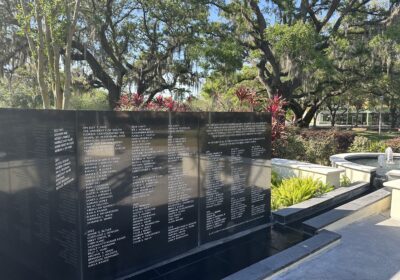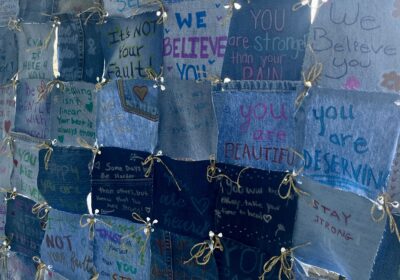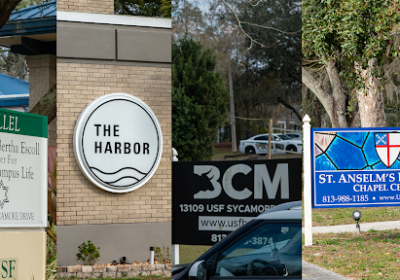Morsani College of Medicine challenged by COVID-19 during first year of operations
A year after the building first welcomed hundreds of new white coats aspiring to begin their medical careers, empty classrooms and silent hallways took over what once was a building designed to encourage collaboration among peers and hands-on learning inside the classroom.
With most of the classes now being delivered online, students, faculty and staff have not been able to benefit from all of what the new Morsani College of Medicine (MCOM) located in Tampa’s Water Street district has to offer as its original plans have been halted due to the coronavirus pandemic.
“COVID hitting [has] really impacted our presence downtown,” Associate Dean of Undergraduate Medical Education Deborah DeWaay said. “We came downtown in January of 2020, and by mid-March [we] were sending everybody home, and [we] still don’t have a full presence in the building.
“We have not had the opportunity, because of COVID, to utilize the building the way it was designed quite yet … in terms of full utilization of the building, we’re probably now a year to 18 months behind really being able to utilize the building as it was intended and designed.”
Among the projects that have been put on hold, Senior Vice President of USF Health and Dean of the USF Morsani College of Medicine Charles Lockwood said that the College of Pharmacy, additional labs and clinical spaces still have to be built. He said construction will take place over the next three years.
Despite the challenges, Lockwood said the pandemic has brought new opportunities to rethink some of the ways the building was used, as well as make new plans to create more clinical spaces to meet the growing demand caused by the virus.
“It’s really been an opportunity to rethink our entire operations and how we deliver care, how we teach, how we do research, how we provide our support services and how can we do those things, not only much more efficiently, but in a way that meets the needs of our workers,” Lockwood said.
With more people working from home, Lockwood said that most office spaces inside the building have gone unused since March, when the pandemic forced hundreds of people to transition to a home office.
The New Normal Committee was then created with the purpose of analyzing unused rooms and floors, such as office spaces, at the building as a way to bring new clinical space to enhance the medical program. By eliminating the commercial real estate the college has been renting, Lockwood said the college would save about $1 million.
For Lockwood, the idea to expand clinical spaces in the building would help the college meet its increasing demand for clinical care across the Tampa Bay area. While the demand was already high before the pandemic, Lockwood said the demand has become “insatiable.”
“The clinical practice has changed, fundamentally, because of telehealth,” he said. “We are almost back to the number of in-person visits that we have for COVID, but we’ve added about 650 telehealth visits per day. So that’s huge. And it dramatically increased our ability to care for patients and some departments like psychiatry.”
The increasing demand for clinical care was followed by the practice of telehealth, as more patients preferred to schedule online appointments due to COVID-19.
Telehealth is widely used by the college as a way to conduct medical appointments through online platforms, like Microsoft Teams. Through a video chat, the patient can receive individualized care without requiring an in-person visit.
As far as delivery of patient care in the midst of the pandemic, Lockwood attributes the success of telehealth to limiting unnecessary hospital admissions.
“Patients far prefer [this alternative], so this is something that we hope never goes away, either. And in a way, almost creates like a new Morsani or a new south Tampa center,” he said.
“If you think about it, they both have about 600 patients a day that they see, so it’s really been exciting, and we continue to refine our telehealth technology to make it more and more efficient. And that’s been another … huge plus from COVID.”
While telehealth has been a less challenging system to implement, transitioning a medical curriculum to an online platform proved no easy feat, according to Lockwood.
“The challenge that COVID initially presented was that we had to, in about a week, transform this whole curriculum of lectures, small group learning and so forth into an online format,” Lockwood said.
MCOM has an agreement with Microsoft to be an innovation center, indicating the facility is an innovative technology center open to students. This partnership has facilitated access to state-of-the-art software and hardware that contributed to the rapid transformation of the curriculum in such a short time frame, according to Lockwood.
“The agreement with Microsoft … really did give us access to not just sophisticated software and hardware but even like Microsoft Teams was already being used all the time in the building so going to all of our meetings through Microsoft Teams was really like normal,” he said.
All classes are conducted online, according to DeWaay. Students only visit the building to take an exam, where around 200 students are spread out across different time slots in the auditorium, which can fit up to 400 people under normal capacity, throughout the day to avoid overcrowding rooms.
“Each room has been put in a very specific spatial formatting to maintain social distancing and each room has a specific number of people it will hold, and it can hold no more than 50% of what the actual capacity is without COVID,” she said.
“The building was designed [so] that we could have both the first- and second-year classes, all in small group rooms, or all in the auditorium, at the same time so that the two schedules would not collide.”
The first two years of medical school are referred to as the “foundational science years,” according to Lockwood, during which students learn subjects on anatomy, physiology, biochemistry and genetics. Students also have a clinical component in their coursework, consisting of subjects like pathology, pathophysiology as well as pharmacology, for example. Lockwood said those subjects are delivered through lectures, labs as well as small group activities.
The third year, known as “clerkships,” is completed at the hospitals while students interact with patients and are instructed by physicians, while during the fourth year, students are given the chance to choose electives that are related to the areas they are interested in pursuing during residency.
Besides using large classrooms and several study rooms across the building for social distancing, Lockwood said the building’s airflow system has also enabled COVID-19 cases to remain low among students, faculty and staff. Consisting of 395,000 square feet of classrooms, labs, study rooms and office spaces, Lockwood said the unused space also allows students and faculty the ability to spread out and follow Centers for Disease Control and Prevention guidelines.
“We had a lot of space for small group learning so we could search the distance there and have face masks, and that worked out really well. And [the USF Center for Advanced Medical Learning and Simulation (CAMLS)] also did a fantastic job prepping the anatomy areas, and standardized patient simulation areas,” Lockwood said.
The changes made to the curriculum and the instruction mode also positively impacted the students’ performance on national board exams, according to Lockwood. He said that students scored the highest grades in the medical program’s history.
“We averaged about a standard deviation above the mean nationally in both step one and step two of their national board exam, so very proud of that,” he said. “We’ve seen about a 20-point increase in their step one performance, a little over 20 points … but the biggest increase was this year so it’s kind of a testament to the quality of the adaptation to COVID.”
Although the pandemic forced the college to modify its education format, DeWaay said these alterations have turned out to be advantageous for the college.
“We’ve been able to deliver a level of education I am incredibly proud of, and we’ve kept our students on track,” DeWaay said.
For Lockwood, the adaptability to teach online, as well as to conduct telehealth appointments, has paid off.
“We’ve had almost no positive [COVID-19 cases] for the last three or four months,” Lockwood said. “The only ones we’ve had have been all community-acquired, and those are essentially stopped as well.”
Looking toward the future, DeWaay hopes for a return to normalcy soon, with more students filling up the classrooms and hallways of the multimillion-dollar building, and believes this experience may impact the function of the college in the future.
“I think at some point we will be back to ‘normal,’” she said. “But I think we will have learned from this experience, so it won’t look exactly as it would have had this not happened.”






